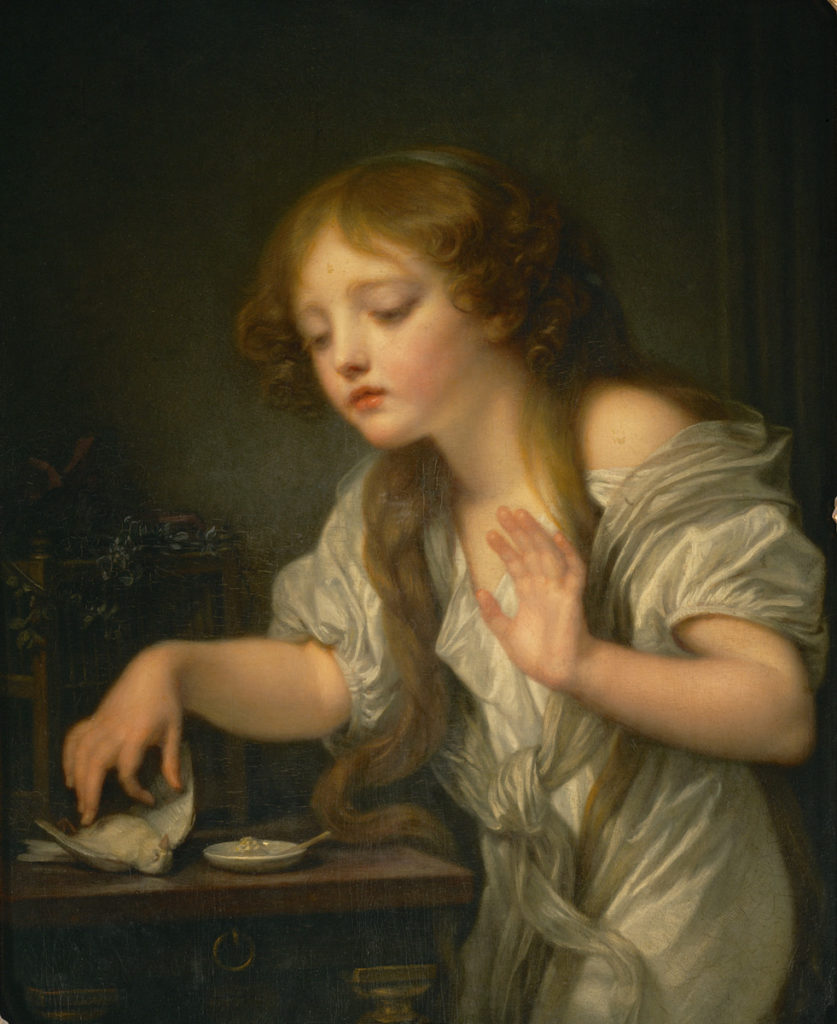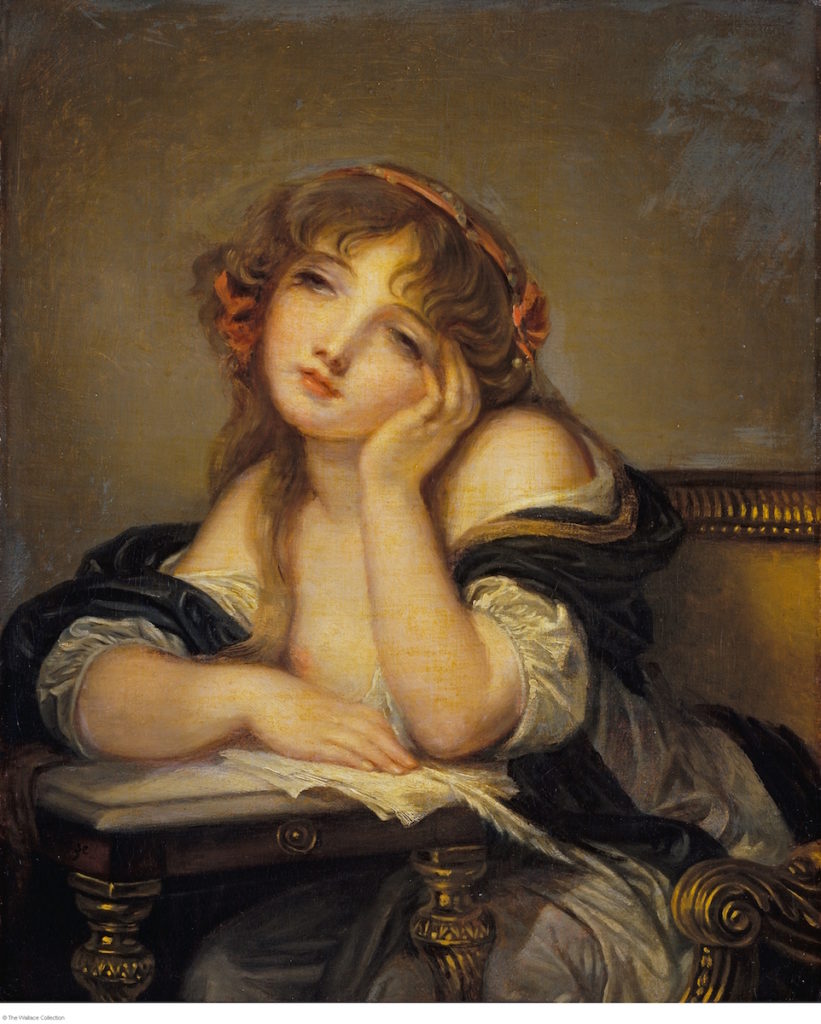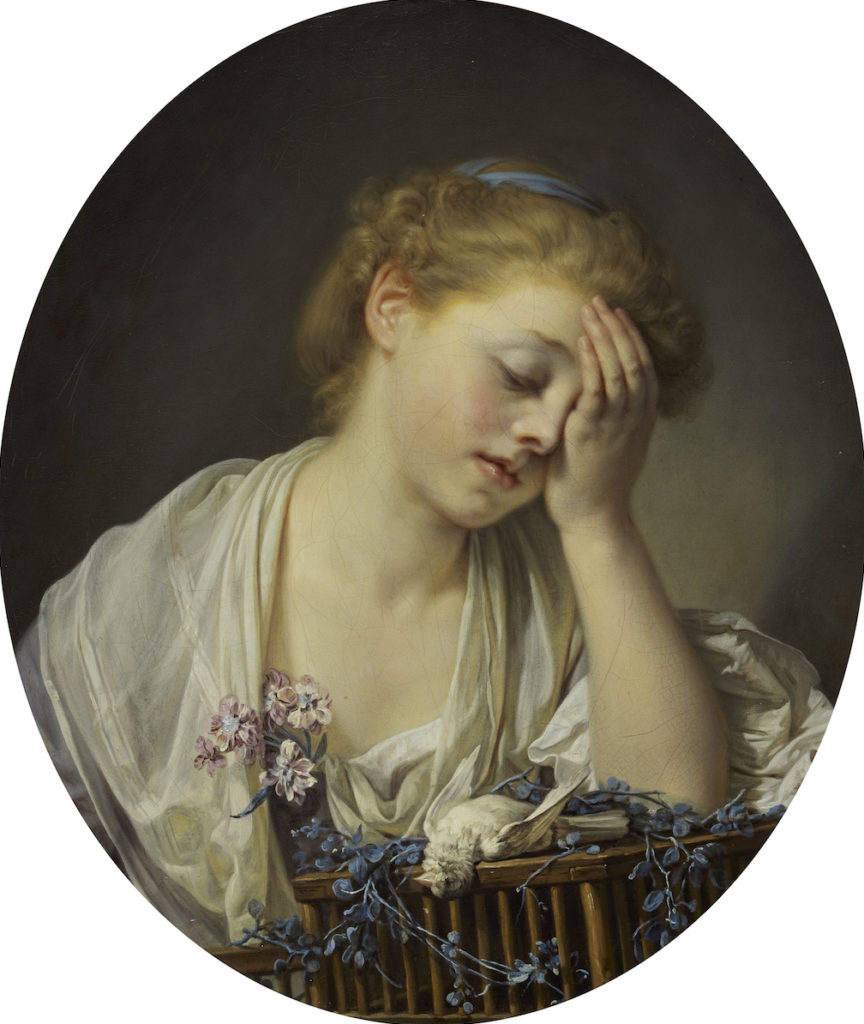Alex Weintraub
The best art critics tend to write with an unmistakable assuredness. Rarely do their essays betray the doubts and uncertainties of an original encounter with a work of art. Yet this certainty, as any student of art history will attest, is not exactly how aesthetic feelings are always formed. Works of art frequently offer us an image of the world that we might not or even could not have been prepared for in advance; and great art, at least according to some aesthetic standards, has that unique capacity to astonish us with its enigmatic appeal. Looking at and writing about art is riddled from the start with second-guessing about what we believe to be the case and why we believe it to be so. By the end of the eighteenth century, these difficulties in deriving valid judgments from one’s visual experience became a widespread preoccupation across a variety of cultural and intellectual fields. In what follows, I propose to examine how the painter Jean-Baptiste Greuze (1725-1805) belatedly grappled with this condition of uncertainty at the heart of critical judgment through his representation of a seemingly dead bird. I will suggest how one of Greuze’s late paintings models this journal issue’s call for “critical and theoretical thinking about animals as more than just symbols and subject matter within visual representation.”

At the Salon of 1800 and after his long absence from that institution, the then 75 year-old Greuze presented his painting Child Hesitating to Touch a Bird for Fear it Might Be Dead alongside its pendant, The Letter Writer (Fig. 1 and Fig. 2). In each work, the artist repeated his formulae for depicting adolescent femininity, but now with a clear re-focusing on reflective acts of decision-making. The letter writer, looking askance in tender reverie, presumably ponders what to send a paramour, while her hesitating compatriot finds herself caught up in a far more philosophical drama of uncertainty. She is represented as a modern doubting Thomas, one who has just encountered something that has caused her to doubt her own sight. Her gestures are divided against each other, with her right hand advancing towards the bird and her left hand rising in countermanding wonder. If this first motion registers the girl’s desire for empirical knowledge, then the second reconstrues this urge as a horrible temptation. Even her eyes, heavy-lidded yet implacable, seem caught somewhere between an analytical will to know and a sentimental impulse to feel.

Scholarship on Greuze has already shed much light on the social, aesthetic, psychological and pedagogical meanings of the artist’s frequent pairing of girls and birds.[1] These works, so we have been told, present contemporary viewers with a great deal of information about how female sexuality was regulated over the course of the eighteenth century. Such erotic valences, for which the bird functions as an object lesson in early amorous attachments, still underlie the lure-like predicament of the 1800 composition. Nevertheless, this work breaks from Greuze’s earlier girl and bird paintings by capturing a moment of hesitation prior to the girl’s full experience of loss. In his earlier 1765 painting of a similar subject, A Girl with a Dead Canary (Fig. 3), now in the collection of the National Galleries of Scotland, Greuze depicts the girl withdrawn in grief with her eyes closed (her left hand even covers her left eye). He also positions her behind her pet, which arches backwards as if out of the picture plane. By contrast, in the 1800 painting, the painter positions the girl and the bird parallel to one another, such that each occupies a more discrete pictorial space of its own. This painting also includes more of the girl’s body, so that we see her actively standing while she surveys the scene, as opposed to leaning in response to it. Finally, the bird in the 1800 version rests in a more stable position on a table for the girl’s inspection, which means that Greuze has re-framed it within the scene of representation, rather than having it appear to breach the pictorial surface, as in the 1765 painting’s trompe l’œil.

All of these compositional differences help foreground the girl’s hesitation as central to the 1800 painting’s meaning. Unlike the artist’s previous girl and bird compositions, Greuze’s girl in 1800 no longer responds to her pet as if its condition were unambiguous. Instead, she encounters an animal that looks remarkably similar to the painter’s other depictions of dead birds, but with a newfound sense of uncertainty. Whereas other Greuze girls express the loss of their birds so completely that their flush-faced despair conveyed to contemporary viewers and later art historians some profounder sense of loss, this Greuze girl is absorbed in a self-legislating act of discernment. As a result, the picture’s drama hinges on the girl’s process of deliberation and the consequences of her conclusion, rather than on her feelings about the bird. If, as Kevin Chua has argued, the earlier girl and bird pictures consisted of an “emotional rather than a rational encounter,”[2] then Greuze’s alteration in 1800 might best be characterized as an attempt to produce a picture that would be inclusive of both dispositions.
In this new pictorial scheme, Greuze’s bird also carries a different significance. Its status is no longer treated as a pictorial pre-given, and has instead transformed into the work’s principle site for reflection. This is because the 1800 composition’s dead bird no longer “commands the conviction”[3] of its original observer. She reaches out towards her pet, yet also recoils from it, as if in doubt as to whether or not her bird is really dead, or unsure as to what kind of response or non-response might be elicited should she decide to give the creature a gentle poke. Of course, these thoughts are the viewer’s own projections, not unlike Denis Diderot’s critical reactions to Greuze’s earlier girl and bird paintings, but they are also intended ones.[4] Greuze composes his picture so that his public would want to know how this girl will proceed, and also to consider why she should now feel so conflicted in her choices.
Should we as viewers preserve the possibility that the bird might still be alive, then we are left with a pictorial drama in which this girl’s testing of her suspicions might also result in her unwitting harassment of her pet. On the other hand, should we accept the far more likely scenario that the bird is in fact dead, then we must grapple with what would be gained and what would be lost (ethically, psychologically, aesthetically) in the girl’s ambivalent urge to reach out and to come to grips with the loss of her pet. Either way, both the adolescent and the viewer come to share a common predicament. This bird seems to be dead, but how do we know? To that end, we might first consider the bird’s posture. The feathered creature lies on its back inert with its wings out-stretched. This is fairly strong evidence of its death to be sure, given that it would be corroborated by comparisons with other pictures made in the very same genre by the artist. Nevertheless, the girl’s hesitation in the 1800 painting implies that this bird’s resemblance to a dead bird might really be just that—a resemblance. She does not yet grieve for her pet, as other Greuze girls had, because she still does not know how she ought to treat it. This is why she ponders whether or not to pluck up the bird with her tweezer-like thumb and index finger. She has not yet decided whether her bird’s motionlessness can be judged as a veritable sign of its lifelessness.
By the close of the eighteenth century, scientists had also questioned this seemingly commonsensical link between death and an organic body’s motionlessness. From popular electrical experiments that appeared to revivify dead birds or to provoke twitching rictuses on the faces of guillotined heads, the French public had by this time become acutely aware that uncanny forms of postmortem motility existed. As Stephanie O’Rourke describes, “the ‘reanimation’ of dead or paralyzed birds, as conducted by Comus [Nicolas-Philippe Ledru], [Charles] Rabiqueau, and countless others” became a common means for demonstrating the physiological effects of electrical currents.[5] What’s more, this new science made it conceivable that “small birds might in many cases be brought back to life [through galvanic irritation] when they fall into a state somewhat resembling death.”[6]
For vitalist scientists like Marie Francois Xavier Bichat, electric media were additionally useful for reconceiving the distinctions between life and death. This was in large part due to their capacity to furnish the experimental grounds for a more refined etiology of voluntary and involuntary movements. Life, according to Bichat’s Physiological Researches (1800), would now be divided into two orders, or between a cognitive, intentional animal life and a mechanistic, reflexive organic one.[7] Each of these two life orders functioned in tandem to resist death, but could do so along its own respective and partially asynchronous timeline, thus making it possible to “re-animate” organic motions even after the mortification of voluntary ones. What could not be recovered fully, even though they could also be made seemingly to reappear (i.e. the difference between a smile and a rictus), were those intentional states of animal life that resulted in movements properly described as voluntary. And while vitalist science tended to treat humans differently from other species with respect to their facultative capacities, as is demonstrated by Bichat’s repellant treatment of laboratory dogs, its partisans understood all creatures, no matter their humanistic prestige, to be prone to the same distinctions between the animal and the organic. Following from this, it becomes all the more plausible to suggest that Greuze’s avian subject might here again, as it had in his previous girl and bird paintings, stand for larger existential concerns related to both his hesitating girl and her Salon public.
Bichat’s workis additionally relevant for an art historical interpretation of Greuze’s painting that treats its bird as seriously as his hesitant girl does. The physiologist also developed on the basis of his experiments a sophisticated account of the faculty of judgment. Ultimately, his research was never intended to render life and death indeterminate to one another; rather it had been conducted with the hope of establishing with far greater precision judgments proper to each of them. He believed that the meaningful determination of a body’s movements, or lack thereof, would require an additional empirical test beyond a scientist’s reasoned observation. This subsequent step was often described in terms of a progression from subjective and visual to objective and tactile knowledge, an evolution analogous to Greuze’s girl’s own. Thus, in the same way that Bichat used electrical currents to chart a canine body’s physiological circuitry in terms of voluntary and involuntary motions, the scientist reasoned that this same animal physiology might also be able to chart the authenticity of human sentiments. As he wrote:
When I see a woman weeping or convulsed at any distressing news, and find her pulse in its natural state, I know what to judge of her affliction […] To judge correctly, we must always compare the external movement with the state of the internal organs. There could be no deceit, were it possible to distinguish the involuntary movements produced in a state of passion, by the action of the heart upon the brain, and then by the reaction of the brain upon the muscles, from the voluntary movements which are occasioned by the simple action of the brain upon the locomotive system.[8]
Now invulnerable to a subject’s deception, Bichat’s materialist reduction of judgment restricted this faculty to interpretations of causes and not reasons, such that complex human emotions could be explained by universal animal criteria. In other words, his tactile match-up of a body’s outward signs (a grimace) with its unseen internal rhythms (heart-rate) would be capable of determining the difference between a subject who was actually dead and one who was merely feigning death, but not of interpreting the subject’s motives should their pose turn out to be judged an imitation.
This account of animal life touches upon more general problems concerning the meaningfulness of any given action. Bichat’s work proposes, firstly, that some movements, inasmuch as they are involuntary, are more physiologically functional than they are philosophically meaningful. A person can’t, for instance, help but sneeze, and yet she can choose to cover her mouth when she does. Second, Bichat’s vitalism proposes that the difference between these two orders of life might be objectively, materially verified, and yet these vitalist judgments would not be capable of addressing themselves further to those far from simple reasons behind the apparently “simple action of the brain upon the locomotive system.” No such automatic recourse to fixed criteria was available for contemporaneous practices of judgment concerned with voluntary actions, such as art criticism. Instead, these late eighteenth-century critics were obliged to provide their own reasons for their beliefs that a given mordant attitude was either authentic or phony.[9]
This returns us to Greuze’s painting and to his girl’s own attempts to judge her bird’s condition. She may be depicted equivocally, but she also appears equally determined not to remain so. Her posture registers the genuine complexity of any encounter with creaturely life. She is depicted alone, left to determine how best to proceed on the basis of her own evaluations. In her cautious regard for her small pet and in her reluctance to verify her suspicions through touch, this young philosopher reminds art historians and critics that even if we were to grasp our own objects as subjects, and to await their potential responsiveness as agents, we should still not expect to bypass the limits and provisional nature of our own critical judgments. We hesitate, and then, eventually, we risk ourselves and decide. The revised moral lesson of this late painting by Greuze is that we can do so without sticking our fingers where they may not belong.
Alex Weintraub is a PhD candidate in Art History and Archaeology at Columbia University, New York, NY
[1] For two recent and compelling accounts, see Emma Barker, “Reading the Greuze Girl: The Daughter’s Seduction,” Representations 117:1 (2012), 86-119; and Kevin Chua, “Dead Birds, or the Miseducation of the Greuze Girl,” in Alden Cavanaugh, ed., Performing the Everyday: The Culture of Genre in the Eighteenth Century (Newark: University of Delaware Press, 2007), 75-91.
[2] Chua, “Dead Birds,” 82.
[3] The expression is taken from Michael Fried, who analyzed Greuze’s work in terms of its depiction of absorptive states. The artist’s late work suggests that even an abstracted state of mind like hesitation or doubt might still be called upon in the service of establishing aesthetic conviction. See Fried, Absorption and Theatricality: Painting and Beholder in the Age of Diderot (Chicago: University of Chicago Press, 1980).
[4] Denis Diderot, “Salon de 1765,” in Salons. Tome 1. Essai sur la peinture (Paris: J. L. J. Brière, 1821), 246: “Mais, petite, votre douleur est bien profonde, bien réfléchie! Que signifie cet air rêveur et mélancolique? Quoi! Pour un oiseau!”
[5] O’Rourke’s scholarship has shed new light on this interconnected history of the nascent life sciences, the arts, and popular attractions. Building on the work of Michel Foucault, O’Rourke finds in this new science an understanding of “death as something coextensive with life,” and she persuasively re-interprets the “partly alive and partly not” bodies in Anne-Louis Girodet’s paintings in light of this potential indeterminacy. See Stephanie O’Rourke, “Bodies of Knowledge: Fuseli and Girodet at the Turn of the Nineteenth Century,” (Phd diss., Columbia University, 2015), 166; and O’Rourke, “Girodet’s Galvanized Bodies,” Art History 41:5 (November 2018), 868-893.
[6] A later description by Alexander von Humboldt of experiments first conducted in 1781 by Franz Carl Achard, as cited in Paul Fleury Mottelay, Bibliographical history of electricity & magnetism, chronologically arranged (London: Charles Griffin & Company Limited, 1922), 262.
[7] Xavier Bichat, Physiological Researches upon Life and Death; Translated from the French by F. Gold (Philadelphia: Smith and Maxwell, 1809), 11-18.
[8] Bichat, Physiological Researches upon Life and Death, 309.
[9] One of Greuze’s critics, for instance, found his girl’s disposition “unnatural” and judged it comparatively with a similar work at the same Salon exhibition. See Barker, “Reading the Greuze Girl,” 110.
Cite this note as: Alex Weintraub, “On Girls and Birds: The Structure of Aesthetic Feelings,” Journal18, Issue 7 Animals (Spring 2019), https://www.journal18.org/3819.
Licence: CC BY-NC
Journal18 is published under a Creative Commons CC BY-NC International 4.0 license. Use of any content published in Journal18 must be for non-commercial purposes and appropriate credit must be given to the author of the content. Details for appropriate citation appear above.
